Film & DVD Review
The Film
A whole series of people died or have gone missing from a house full of a strange atmosphere in the suburb of Tokyo. It is said that the owner of the house murdered his wife before he committed suicide. Their 6 year old son was never found. A volunteer home-care worker, Nishina Rika (Megumi Okina), comes to the house and finds a mysterious boy, who then suddenly disappears. Then, more terrible things happen and all the people related to her die one after another. The horror keeps growing...
For making genuinely scary films, and not the Hollywood version of horror films, Japan has been one of the world leaders for a while now. Hollywood was getting better, making a few good highly suspenseful films, but then proved that it couldn't compete by deciding to remake as many Asian horror films as they could find. Several of these came from Japan. Indeed it was possibly the classic Ring which really put Japan on the world stage for horror films. Since then there have been several others worth mentioning, Dark Water being one of my personal favourites, and now Ju-On: The Grudge.
From what I have read Takashi Shimizu originally made Ju-On as a TV film. Apparently that effort lacked budget, among other things, and was not a great success. But with more money, the TV Ju-On was remade as this film. I'm no historian, so some of that may be wrong, but it is what I recall reading. Anyway there were 2 Ju-On TV movies, and this is the first of 2 theatrical Ju-On movies. Hope everything is clear!
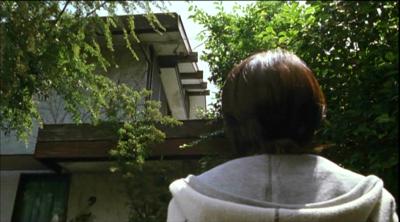
Ju-On is simply about a house; a cursed house to be exact. 5 years prior to the main time frame of the film, a man brutally murdered his wife in the house, before killing himself. Their 6-year-old son was never found. At the present time, the curse in the house grows and starts to affect all who enter - they will all die. The story is told in a series of short stories, six to be precise, all related to each other, but not necessarily in chronological order. Imagine the narrative of a film like Pulp Fiction and you should know what the narrative in Ju-On is like. The stories focus on the cop who investigated the original murder in the house five years ago and his daughter, a family that move into the house about five years after the murder, a care-worker who comes into to care for the husband's mother and of course the wife who was murdered in the house. The non-chronology of the narrative ensure that you only learn more information to piece together the story when and where the story wants you to learn something, adding to the suspense of the film.
I deliberately was as vague as possible in describing the film's plot, as Ju-On is one of those films where your knowledge, or lack of, of what is going on greatly adds to the suspense and scariness of the film. It is not an action packed film, there are no gore scenes; it is entirely story driven, and a very effective story it is. Being given snippets of information at a time, I found I was sucked into the film, wondering what was going to happen next, who the people were and if I was going to absolutely sh!t myself in the next scary scene.
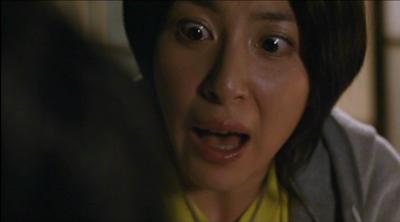
Personally, I found Ju-On to be one of the most genuinely scary films I've seen in a while. It was right up there with A Tale Of Two Sisters, in the scariness factor, possibly surpassing it slightly. Maybe I'm just getting into the films more these days, but I've always thought I was someone who is quite hard to scare. But quite a few of these Asian horror films are succeeding. I could have just become desensitised to the Hollywood formula for scary films, which is why I wasn't scared easily in films, but with the different approach that is used in Japan and the other Asian countries, they could be tapping a nerve that hadn't been touched before. Whatever it is, Ju-On is a proper scary film.
Compared to the classic Ring, Ju-On is very different in approach. Where Ring was slow paced, but constantly building up the tension and suspense to the infamous and outstanding finale, Ju-On's non-linear narrative allows it to be completely different in style. There is no slow build up of suspense or tension, it builds up quickly and stays there. With six short stories there are six endings, six finales. In a 90-minute film, that is one every 16 minutes, on average. Rather than one huge scare at the end, there are six big scares, with many several smaller ones frequently spaced throughout each story. This is why Ju-On is so scary. It does not give you time to relax and recover. The smaller scares warm you up for the bigger one at the end of the story, but another story follows. A bonus of this short story style for the film is that the slight lull at the beginning of each section as that story is getting going, comes as you are still recovering from the finale scare of the previous story. Once you're better, you are straight back into the thick of the next story.
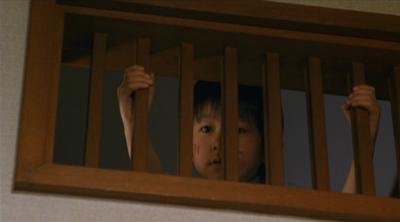
While the story is definitely good, as a film Ju-On is not quite up there with A Tale Of Two Sisters. The film is not not nearly as clever as the latter, nor is it quite as engaging. Even though the narrative is not linear, there are no twists or surprises in what you learn, which is something I was honestly expecting. This was a shame as I felt there was a lot of potential for a very clever story that would keep the viewer guessing and scared right until the very end. Only the scared side of that was realised.
In all the horror films I've seen in recent years, there has pretty much always been one thing that they all have in common; a Sadako (from Ring) style character. Dark Water had one, as did A Tale Of Two Sisters, likewise with Inner Senses, and so does Ju-On. The black hair flows over the face, and the character's movements are jerky and unnatural looking. A bit of originality comes into it here as this character is given its own sound effect, a rather creepy cross between creaking and cackling. You'll probably have to hear it to get what I mean. Why do all these horror films use this type of character? Best probably answer is, because it works! There is something about the look of these characters, the hidden face, their unnaturalness (if that's a word), which just makes them scary. None of them from any of these films have managed to compete with Sadako though.
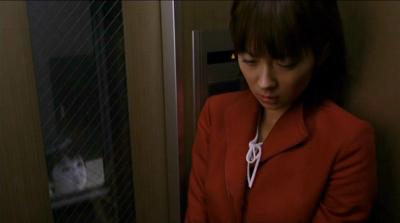
Ju-On, however, introduces another bloody freaky (in the scary sense) character; the little boy Toshio (the kid on the front cover). Yes, in the film he does look that scary. His skin has a definite blue hue to it, and his eyes are black. Other than that he looks like a normal boy, but it is his actions that bring him up to the really freaky levels. The way he sits and stares with wide eyes, his silence and, despite his very small frame, his general presence makes him very scary. I would be completely freaked out if I saw him in real life, that is for sure. With Toshio, Ju-On introduces the first effective original character in a horror film, that I've seen in a long time.
To make the majority of the scares in the film, the simplest of techniques is used. In the audio, it is silence. In a creepy situation, would you be more scared if everything was dead silent, or if there were lots of noises, music etc, to take your mind of the fear? Silent of course. The same applies here. With the silence you can practically hear every breath from the character on screen, as well as your own. I found myself hoping the scare would just hurry up and happen, cause the suspense was killing me (not literally)! In the visual, there was no fancy CG or anything like that to instil fear, most of the time there was just obstruction. Wherever the scare was lurking, it was always just around the corner, behind a door, in the next room, or just off camera shot. You have no idea what you are going to see when the character goes round that corner, opens that door etc. The unknown is scary. People are generally scared of the unknown, this is why the film is very effective. Credit to this must also go to the layout of the house. While it looks perfectly normal, the right angle in the stairs, the bars on the top landing, the positioning of the doors to the rooms, all of this must have been meticulously thought out and planned to maximise the potential for fear. Regardless of where a character is in the house, they are blind to the vast majority of it, where anything could be happening.
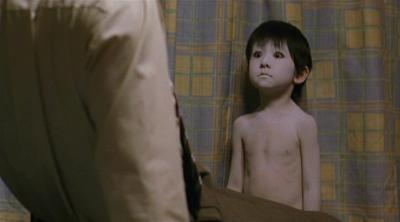
In the acting department, it was a little bit of a mixed bag. Aside from the character Rika, no one else really had the amount of screen time required to make his or her performance highly memorable. I certainly don't think anyone in this film was below par, but the six stories focus on about 8 or 9 people. With Rika (Megumi Okina) getting the most screen time, it is possibly no surprise that, for me, she came across the best of all the cast. She had good facial reactions for being scared, making her fear really quite believable. Special mention has to go to the kid who played Toshio... he looked damn scary!
Ju-On while being another Japanese horror film, should not simply be dismissed as another horror film. It is up there with the best in the genre, and for a scares-per-minute average it also scores very highly.
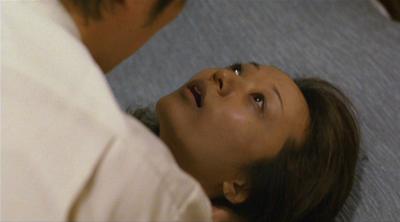
Audio & Subtitles
The only original language audio track on the DVD is a Japanese Dolby Digital 5.1 track, and as such was the easy choice from them all. Ju-On is a films that employs silence to make a lot of the scenes scarier, so there isn't really anything in the soundtrack that would prove taxing. There is only limited surround speaker use, as most of the audio comes from the front centre speaker, but the surrounds are used every now and then. My biggest gripe with the audio track is that the volume balance levels are a bit off. For the majority of the time the volume levels are fine, but when there is someone speaking in another room or something like that, and their voice is meant to be quiet, it is too quiet. The first time this happened, the subtitles started to come on screen subtitling speech that wasn't even aware was being spoken! This happens on a few occasions, and does get a little irritating. The creaks and other scary sound effects all do their job well.
Not much to say about the English subtitles really, other than they are very good. There is literally a couple of spelling and grammar errors in the whole film, and their timing appears to be spot on. So no complaints from me!
Quality
This Thai release of Ju-On comes with an anamorphic widescreen transfer. The print is very clean, with minimal speckling or dirt. It is, however, a little soft at times and slight amount of grain is evident in places. Colours seem to be reproduced well, and there was no evidence of colour bleeding. The print could have done with being a little sharper, but other than that I was very happy with it.

DVD & Extras
This release comes with an outer slipcase covering the normal DVD case. This slipcase has a cool little hologram picture on the front, alternating between the blue colured creepy boy face and a frightened woman's face.
The DVD is an absolute bare-bones release, with no extras at all. The menus are in both English and Thai, and the DVD comes packaged in a rather funky slipcase. The slipcase has a hologram type postcard on the front, changing between the scary face of the little kid, and the scared face of a woman.
Overall
If Quentin Tarintino made a horror film, he make one along similar lines to Ju-On, but not as good (let the flame war begin!!). The non-linear narrative is both a great plus and a minus for the film at the same time. A plus as it enables far more scares to be bought into play, but a minus as expectations are made for something special in the story which does not materialise. Regardless Ju-On is a top scary movie, and one which should definitely be checked out, and for US$10.50 delivered from ethaicd.com, you'd be a fool not to!
Film:     
DVD:     
Buy this film at

|
|

